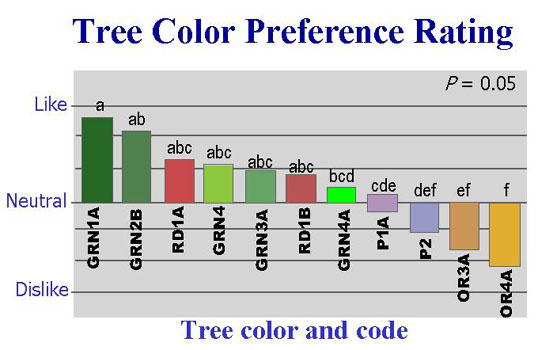INTRODUCTION
OBJECTIVES
METHODS
RESULTS AND DISCUSSION

CONCLUSION
Does Plant Color Affect Emotional Responses To Landscapes?Andrew J. Kaufman and Virginia I. LohrDept. of Horticulture and Landscape Architecture Washington State Univ., Pullman, WA, USA 99164-6414 - based on a poster presented at the 27th International Horticultural Congress in Toronto, Canada. - Printed version: Kaufman, A.J. and V.I. Lohr. 2004. Does plant color affect emotional and physiological responses to landscapes? Proc. XXVI International Horticultural Congress. Acta Horticulturae 639:229-233. |
|
INTRODUCTION |
| Color
has
been studied since ancient times in many cultures.
Surprisingly, few studies have addressed plant color and
its influence on people. Extending research to
investigate whether different plant colors contribute to
exciting or calming landscapes could have tremendous
economic and social impacts. This poster discusses Phase
1 of a two phase research study addressing what effect
plant colors have on people’s emotional and
physiological states. Phase 1 focuses on general plant
color preference ratings. Phase 2 will monitor emotional
and physiological responses to tree colors. |
|
OBJECTIVES |
| The
hypothesis
that viewing trees of different colors will evoke
different emotions was developed based on evolutionary
survival theories. Colors could be cues associated with
long and short term landscape sustainability. For
instance, deep green foliage might indicate a nutritious
plant with high sugar and carbohydrate content and evoke
a positive emotion, whereas yellow foliage might
indicate a nutrient deficiency and elicit a negative
response. The objective of Phase 1 was to determine the
range of tree colors that evoke human responses. |
|
METHODS |
| Phase
1
used a simple methodology, preference ratings, to
examine responses to a range of hues and intensities.
Nine respondents (ages 27 to 77) were shown
computer-generated images of one tree form in 52
different colors (such as those shown on the top corner
of this poster). They were asked which trees they liked
and disliked. After this, a subset of images of the tree
in 11 colors was selected. It included colors that
consistently evoked very positive or very negative
ratings. Yellow hues, for example, were not included in
the subset, because they tended to receive neutral
ratings. The subset of colors was then shown to 24
respondents (ages 20 to 61). Respondents were asked to
rate each tree color by saying which they liked,
disliked, or felt neutral about. Results from these 24
respondents are presented. |
|
RESULTS AND DISCUSSION |
 |
|
CONCLUSION |
| Phase
1
showed that people exhibit strong responses to a range
of tree colors, varying in hue and intensity. Generally,
greens and reds were preferred to purples, oranges, and
browns. Phase 2 will determine whether these preferences
are associated with physiological responses as well. |
| Return
to: Canopy Color page Human Issues in Horticulture Research page Andrew J. Kaufman Virginia Lohr (E-mail: lohr@wsu.edu ) Department of Horticulture Washington State University Pullman, Washington 99164-6414 U.S.A. WSU's Disclaimer & Freedom of Expression Policy - Updated March 20, 2015
|